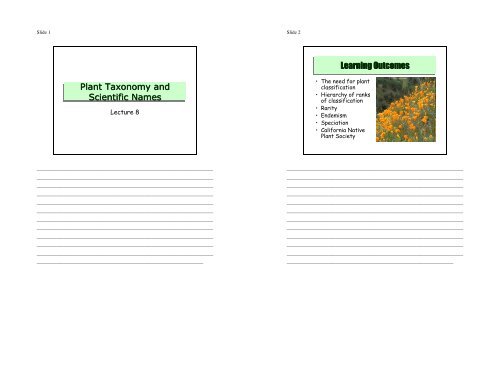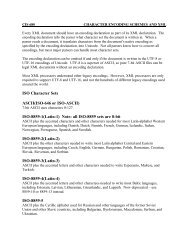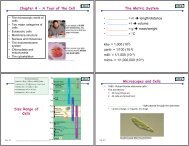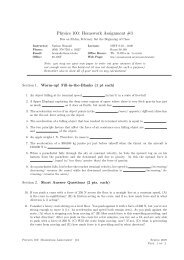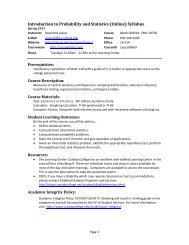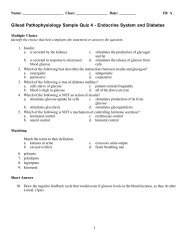Lecture 8 Plant Taxonomy and Scientific Names
Lecture 8 Plant Taxonomy and Scientific Names
Lecture 8 Plant Taxonomy and Scientific Names
Create successful ePaper yourself
Turn your PDF publications into a flip-book with our unique Google optimized e-Paper software.
Slide 1<br />
Slide 2<br />
Learning Outcomes<br />
<strong>Plant</strong> <strong>Taxonomy</strong> <strong>and</strong><br />
<strong>Scientific</strong> <strong>Names</strong><br />
<strong>Lecture</strong> 8<br />
• The need for plant<br />
classification<br />
• Hierarchy of ranks<br />
of classification<br />
• Rarity<br />
• Endemism<br />
• Speciation<br />
• California Native<br />
<strong>Plant</strong> Society<br />
________________________________________________________________________<br />
________________________________________________________________________<br />
________________________________________________________________________<br />
________________________________________________________________________<br />
________________________________________________________________________<br />
________________________________________________________________________<br />
________________________________________________________________________<br />
________________________________________________________________________<br />
________________________________________________________________________<br />
________________________________________________________________________<br />
________________________________________________________________________<br />
____________________________________________________________________<br />
________________________________________________________________________<br />
________________________________________________________________________<br />
________________________________________________________________________<br />
________________________________________________________________________<br />
________________________________________________________________________<br />
________________________________________________________________________<br />
________________________________________________________________________<br />
________________________________________________________________________<br />
________________________________________________________________________<br />
________________________________________________________________________<br />
________________________________________________________________________<br />
____________________________________________________________________
Slide 3<br />
Slide 4<br />
The Need for <strong>Plant</strong> Classification<br />
• Some plants are edible<br />
• Some plants are<br />
inedible<br />
• Some plants are<br />
deadly<br />
• Neolithic cultures<br />
(pre-agriculture)<br />
dependent upon<br />
identifying wild plants<br />
• To communicate with<br />
others they needed<br />
names<br />
• Linnaeus<br />
– Systema Naturae 1735<br />
• Grouped plants (<strong>and</strong><br />
animals) based upon<br />
similar structures<br />
• Ordered groups in to a<br />
hierarchy<br />
• Used Latin<br />
• Universal language of<br />
science<br />
<strong>Plant</strong> <strong>Taxonomy</strong><br />
________________________________________________________________________<br />
________________________________________________________________________<br />
________________________________________________________________________<br />
________________________________________________________________________<br />
________________________________________________________________________<br />
________________________________________________________________________<br />
________________________________________________________________________<br />
________________________________________________________________________<br />
________________________________________________________________________<br />
________________________________________________________________________<br />
________________________________________________________________________<br />
____________________________________________________________________<br />
________________________________________________________________________<br />
________________________________________________________________________<br />
________________________________________________________________________<br />
________________________________________________________________________<br />
________________________________________________________________________<br />
________________________________________________________________________<br />
________________________________________________________________________<br />
________________________________________________________________________<br />
________________________________________________________________________<br />
________________________________________________________________________<br />
________________________________________________________________________<br />
____________________________________________________________________
Slide 5<br />
Slide 6<br />
• Kids = Kingdom<br />
• Dodging = Division<br />
• Cars = Class<br />
• On = Order<br />
• Freeways = Family<br />
• Get = Genus<br />
• Splatted = Species<br />
Kids <strong>and</strong> Cars<br />
Major <strong>Plant</strong> Groups<br />
• Kingdom – <strong>Plant</strong>ae<br />
• Disagreement how best to divide<br />
Divisions <strong>and</strong> Classes<br />
• Divisions - Bryophyta –<br />
– Non-Vascular <strong>Plant</strong>s<br />
• Mosses, liverworts<br />
• Vascular <strong>Plant</strong>s<br />
• Tracheophyta<br />
– Spore producing Ferns<br />
• Seed plants<br />
– Gymnosperms, ‘naked seeds’ include<br />
conifers<br />
• Angiosperms<br />
________________________________________________________________________<br />
________________________________________________________________________<br />
________________________________________________________________________<br />
________________________________________________________________________<br />
________________________________________________________________________<br />
________________________________________________________________________<br />
________________________________________________________________________<br />
________________________________________________________________________<br />
________________________________________________________________________<br />
________________________________________________________________________<br />
________________________________________________________________________<br />
____________________________________________________________________<br />
________________________________________________________________________<br />
________________________________________________________________________<br />
________________________________________________________________________<br />
________________________________________________________________________<br />
________________________________________________________________________<br />
________________________________________________________________________<br />
________________________________________________________________________<br />
________________________________________________________________________<br />
________________________________________________________________________<br />
________________________________________________________________________<br />
________________________________________________________________________<br />
____________________________________________________________________
Slide 7<br />
Slide 8<br />
Order<br />
A Family Affair<br />
• Level above Family<br />
• Several families<br />
grouped in same order<br />
• Suffix – ALES<br />
• Rosales<br />
– Moraceae – Fig Family<br />
– Rosaceae – Rose family<br />
– Rhamnaceae –<br />
Buckthorn family<br />
• Cucurbitales -<br />
Squashes<br />
• All members of a<br />
family share common<br />
ancestry<br />
• Recognized by similar<br />
structures<br />
• Flowers, fruit leaves<br />
• Family ending aceae<br />
• E.g. Ericaceae<br />
• All have bell shaped<br />
flowers<br />
Enkianthus campanulatus<br />
________________________________________________________________________<br />
________________________________________________________________________<br />
________________________________________________________________________<br />
________________________________________________________________________<br />
________________________________________________________________________<br />
________________________________________________________________________<br />
________________________________________________________________________<br />
________________________________________________________________________<br />
________________________________________________________________________<br />
________________________________________________________________________<br />
________________________________________________________________________<br />
____________________________________________________________________<br />
________________________________________________________________________<br />
________________________________________________________________________<br />
________________________________________________________________________<br />
________________________________________________________________________<br />
________________________________________________________________________<br />
________________________________________________________________________<br />
________________________________________________________________________<br />
________________________________________________________________________<br />
________________________________________________________________________<br />
________________________________________________________________________<br />
________________________________________________________________________<br />
____________________________________________________________________
Slide 9<br />
Slide 10<br />
All in the Family<br />
• Reproductive<br />
structures<br />
• Flower anatomy<br />
• Basis for<br />
classification<br />
• Rosaceae<br />
– Silverweed<br />
– Cotoneaster<br />
– Blackberry<br />
• Always capitalized<br />
• Contains one to many<br />
different species<br />
• Generally descriptive<br />
• Eucalyptus = true<br />
capsule describing<br />
woody fruit<br />
• 700 different species<br />
Genus<br />
________________________________________________________________________<br />
________________________________________________________________________<br />
________________________________________________________________________<br />
________________________________________________________________________<br />
________________________________________________________________________<br />
________________________________________________________________________<br />
________________________________________________________________________<br />
________________________________________________________________________<br />
________________________________________________________________________<br />
________________________________________________________________________<br />
________________________________________________________________________<br />
____________________________________________________________________<br />
________________________________________________________________________<br />
________________________________________________________________________<br />
________________________________________________________________________<br />
________________________________________________________________________<br />
________________________________________________________________________<br />
________________________________________________________________________<br />
________________________________________________________________________<br />
________________________________________________________________________<br />
________________________________________________________________________<br />
________________________________________________________________________<br />
________________________________________________________________________<br />
____________________________________________________________________
Slide 11<br />
Slide 12<br />
• Always lower case<br />
– specific<br />
• Descriptive or<br />
honorary or fanciful<br />
• Each species has a<br />
unique Latin binomial<br />
• Eucalyptus sideroxylon<br />
• E. globulus<br />
• Genus name can be<br />
shortened once the<br />
Genus name has been<br />
given in FULL<br />
Specific Name<br />
Using Latin binomials<br />
• Typing<br />
– Italicize<br />
• Writing<br />
– Underline<br />
• Abbreviating the<br />
Genus<br />
– Risk of confusion<br />
– Several genera<br />
start with same<br />
letter<br />
________________________________________________________________________<br />
________________________________________________________________________<br />
________________________________________________________________________<br />
________________________________________________________________________<br />
________________________________________________________________________<br />
________________________________________________________________________<br />
________________________________________________________________________<br />
________________________________________________________________________<br />
________________________________________________________________________<br />
________________________________________________________________________<br />
________________________________________________________________________<br />
____________________________________________________________________<br />
________________________________________________________________________<br />
________________________________________________________________________<br />
________________________________________________________________________<br />
________________________________________________________________________<br />
________________________________________________________________________<br />
________________________________________________________________________<br />
________________________________________________________________________<br />
________________________________________________________________________<br />
________________________________________________________________________<br />
________________________________________________________________________<br />
________________________________________________________________________<br />
____________________________________________________________________
Slide 13<br />
Slide 14<br />
Using Common <strong>Names</strong><br />
• Only reliable if context is<br />
understood by all parties<br />
• Examples<br />
– Buckeye<br />
• Many plant species may have<br />
same common name<br />
• Several different common<br />
names for one plant species<br />
• Regional names<br />
– California Bay a.k.a. Oregon Myrtle<br />
• Different common name for<br />
each language<br />
• Each level of<br />
classification<br />
fits into the<br />
next larger<br />
unit of<br />
classification<br />
Hierarchical Nature of<br />
Classification<br />
________________________________________________________________________<br />
________________________________________________________________________<br />
________________________________________________________________________<br />
________________________________________________________________________<br />
________________________________________________________________________<br />
________________________________________________________________________<br />
________________________________________________________________________<br />
________________________________________________________________________<br />
________________________________________________________________________<br />
________________________________________________________________________<br />
________________________________________________________________________<br />
____________________________________________________________________<br />
________________________________________________________________________<br />
________________________________________________________________________<br />
________________________________________________________________________<br />
________________________________________________________________________<br />
________________________________________________________________________<br />
________________________________________________________________________<br />
________________________________________________________________________<br />
________________________________________________________________________<br />
________________________________________________________________________<br />
________________________________________________________________________<br />
________________________________________________________________________<br />
____________________________________________________________________
Slide 15<br />
Slide 16<br />
Naming New <strong>Plant</strong> Species<br />
• New never before<br />
seen plants still found<br />
in CA<br />
• Tiburon Mariposa Lily<br />
1973<br />
• Calochortus<br />
tiburonensis<br />
• Shasta Snow Wreath<br />
Neviusia cliftonii<br />
• 1992<br />
• <strong>Names</strong> must follow<br />
protocol<br />
– International Code of<br />
Botanical Nomenclature<br />
• Formal description in<br />
Latin<br />
• Type specimen first<br />
specimen collected<br />
– held in Herbarium<br />
Collection<br />
– Reference available to<br />
researchers<br />
• California Academy of<br />
Sciences<br />
• Jepson Herbarium UC<br />
Berkeley<br />
Herbaria<br />
________________________________________________________________________<br />
________________________________________________________________________<br />
________________________________________________________________________<br />
________________________________________________________________________<br />
________________________________________________________________________<br />
________________________________________________________________________<br />
________________________________________________________________________<br />
________________________________________________________________________<br />
________________________________________________________________________<br />
________________________________________________________________________<br />
________________________________________________________________________<br />
____________________________________________________________________<br />
________________________________________________________________________<br />
________________________________________________________________________<br />
________________________________________________________________________<br />
________________________________________________________________________<br />
________________________________________________________________________<br />
________________________________________________________________________<br />
________________________________________________________________________<br />
________________________________________________________________________<br />
________________________________________________________________________<br />
________________________________________________________________________<br />
________________________________________________________________________<br />
____________________________________________________________________
Slide 17<br />
Slide 18<br />
Classification Active Area of<br />
Research<br />
• Classifying new species<br />
• Underst<strong>and</strong>ing<br />
evolutionary relationships<br />
among plant groups<br />
• New techniques<br />
– DNA analysis<br />
• Reclassification<br />
• Families merged or split<br />
• Scrophulariaceae<br />
chopped up<br />
• Field Guides<br />
– Regional<br />
– By group e.g. Ferns<br />
• Flora<br />
• Every species in<br />
state/country<br />
• Dichotomous Keys<br />
• Series of questions with<br />
“Yes” or “No” answers<br />
Identifying <strong>Plant</strong>s<br />
________________________________________________________________________<br />
________________________________________________________________________<br />
________________________________________________________________________<br />
________________________________________________________________________<br />
________________________________________________________________________<br />
________________________________________________________________________<br />
________________________________________________________________________<br />
________________________________________________________________________<br />
________________________________________________________________________<br />
________________________________________________________________________<br />
________________________________________________________________________<br />
____________________________________________________________________<br />
________________________________________________________________________<br />
________________________________________________________________________<br />
________________________________________________________________________<br />
________________________________________________________________________<br />
________________________________________________________________________<br />
________________________________________________________________________<br />
________________________________________________________________________<br />
________________________________________________________________________<br />
________________________________________________________________________<br />
________________________________________________________________________<br />
________________________________________________________________________<br />
____________________________________________________________________
Slide 19<br />
Convergent Forms<br />
• Classification<br />
based upon<br />
anatomy<br />
• However,<br />
different groups of<br />
plants share similar<br />
adaptations to<br />
similar<br />
environments<br />
________________________________________________________________________<br />
________________________________________________________________________<br />
________________________________________________________________________<br />
________________________________________________________________________<br />
________________________________________________________________________<br />
________________________________________________________________________<br />
________________________________________________________________________<br />
________________________________________________________________________<br />
________________________________________________________________________<br />
________________________________________________________________________<br />
________________________________________________________________________<br />
____________________________________________________________________


